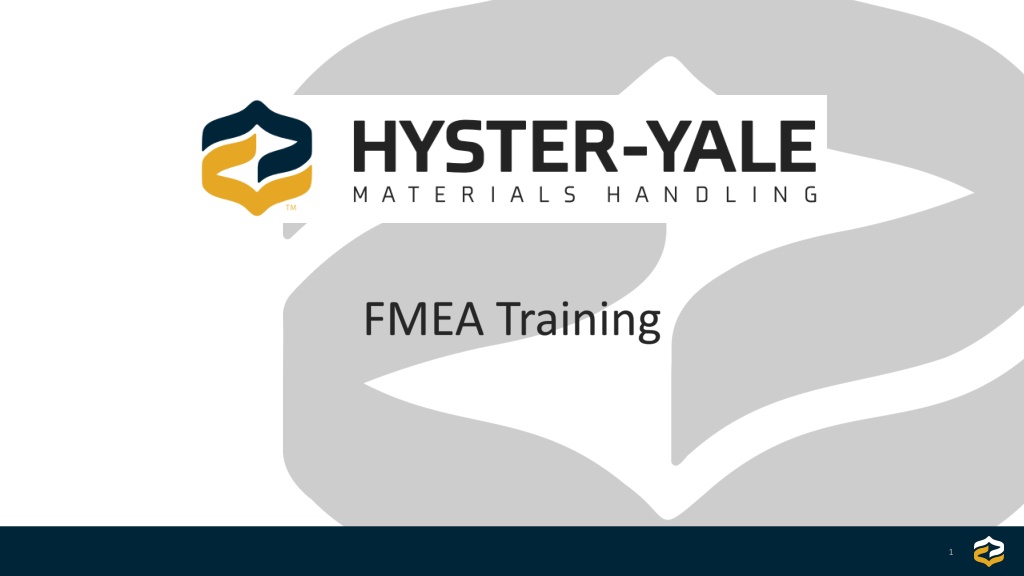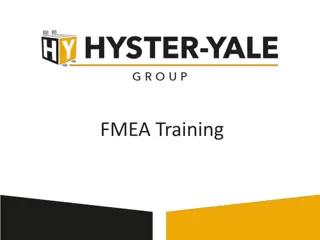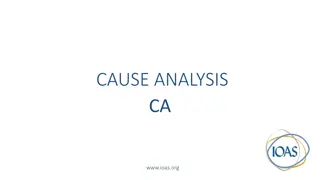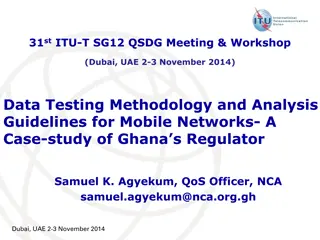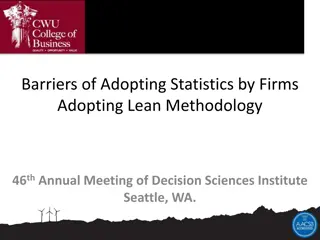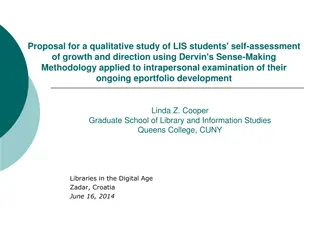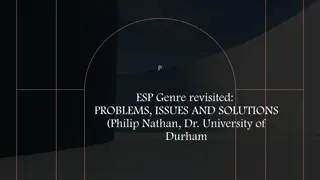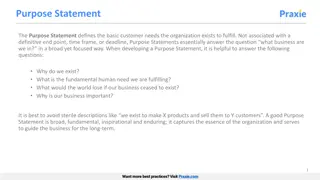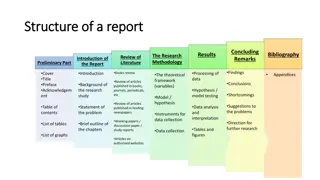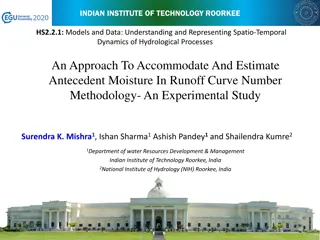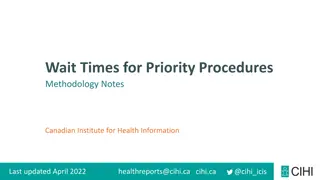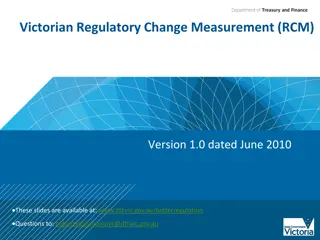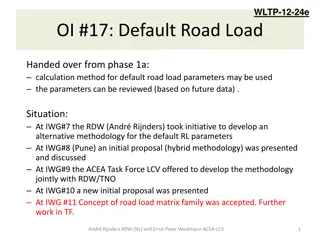Understanding the Purpose and Methodology of FMEA
Failure Mode and Effects Analysis (FMEA) is a valuable methodology that helps in identifying and eliminating potential defects early in the process or design development stages. It aims to improve customer satisfaction, manage risks, and prevent issues before they occur. FMEA is a useful tool for process improvement and is often required by customers as part of quality standards.
Download Presentation

Please find below an Image/Link to download the presentation.
The content on the website is provided AS IS for your information and personal use only. It may not be sold, licensed, or shared on other websites without obtaining consent from the author. Download presentation by click this link. If you encounter any issues during the download, it is possible that the publisher has removed the file from their server.
E N D
Presentation Transcript
Purpose of the FMEA Preventive costs Cost of validation Warranty costs Identify and eliminate potential defects Detection and correction of defects Detection and correction EXTERNAL defects Validation tests P-FMEA D-FMEA Product development Project planning Pre- production Production Lifetime Customer Manufacturer / supplier Preventivecosts to identify potential defects by FMEA s are relatively low compared to in-house detection and correction of defects and even much lower than recovery costs in case defects are found by our Customers. 9/26/2024 2
Purpose of the FMEA PURPOSE OF THE FMEA: Methodology that facilitates process improvement Identifies and eliminates concerns early in the development of a process or design Improve internal and external customer satisfaction Risk Management tool, focuses on prevention FMEA may be a customer requirement (likely contractual, Level 3 PPAP, ISO 9001) 3 9/26/2024 3
LEARNING FMEA, TRAINING OBJECTIVES TRAINING OBJECTIVES: TO UNDERSTAND THE USE OF FAILURE MODES AND EFFECT ANALYSIS(FMEA) TO LEARN THE STEPS TO DEVELOPING FMEAS TO SUMMARIZE THE DIFFERENT TYPES OF FMEAS TO LEARN HOW TO LINK THE FMEA TO OTHER PROCESS TOOLS 4 9/26/2024 4
FMEA, SUMMARY FMEA, A MATHEMATICAL WAY TO IDENTIFY: Failure modes, the ways in which a product or process can fail The Effects and Severity of a failure mode Potential causes of the failure mode The Occurrence of a failure mode The Detection of a failure mode The level of risk (Risk Priority Number) Actions that should be taken to reduce the RPN RPN = Severity X Occurrence X Detection 5 9/26/2024 5
FMEA, Inputs Inputs might include other tools such as: D-FMEA (Part and Assembly level) Defines VOC Customer requirements CTQ Flow down analysis Quality Function Deployment (House Of Quality) Risk assessments P-FMEA (Process level) Delivers VOC Process flowchart Sequence Of Events Process Tooling Poka-Yoke list 6 9/26/2024 6
FMEA, APPLICATION EXAMPLES THERE ARE SEVERAL SITUATIONS WHERE AN FMEA IS THE OPTIMAL TOOL TO IDENTIFY RISK: PROCESS-FMEA: Introducing a new process Reviewing existing processes after modifications Introduce new Part Numbers on an existing Production Line DESIGN-FMEA: Introducing a new Design, Part, Sub Assembly or Assembly Use an existing Design for another application Reviewing existing Designs after modifications 7 9/26/2024 7
WHAT IS A FAILURE MODE? A FAILURE MODE IS: The way in which the component, subassembly, product or process could fail to perform its intended function Failure modes may be the result of previous operations or may cause next operations to fail Things that could go wrong INTERNALLY: Warehouse Production Process Things that could go wrong EXTERNALLY: Supplier Location Final Customer 8 9/26/2024 8
WHEN TO CONDUCT AN FMEA WHEN TO CONDUCT AN FMEA? EARLY IN THE NEW PRODUCT INTRODUCTION (A-BUILD) COMPLETE FOR B BUILD. WHEN NEW SYSTEMS, PRODUCTS, AND PROCESSES ARE BEING DESIGNED WHEN EXISTING DESIGNS OR PROCESSES ARE BEING CHANGED, FMEA S TO BE UPDATED WHEN PROCESS IMPROVEMENTS ARE MADE DUE TO CORRECTIVE ACTION REQUESTS 9 9/26/2024 9
HISTORY OF FMEA History of FMEA: First used in the 1960 s in the Aerospace Industry during the Apollo Missions In 1974, the Navy developed MIL-STD-1629 regarding the use of FMEA In the late 1970 s, the Automotive Industry was driven by liability costs to use the FMEA Later, the Automotive Industry saw the advantages of using this tool to reduce risks related to poor Quality (QS-9000, VDA and ISO-TS 16949 Standards) 10 10 9/26/2024 10
TYPES OF FMEAS DESIGN FMEA Analyzes product design before release to production, with a focus on product function Analyzes systems and subsystems in early concept and design stages PROCESS FMEA Used to analyze manufacturing and assembly processes before they are implemented 11 9/26/2024 11
FMEA: A TEAM TOOL A TEAM APPROACH IS NECESSARY TEAM SHOULD BE LED BY THE RIGHT PERSON, DESIGN, MANUFACTURING OR QUALITY ENGINEER, ETC FAMILIAR WITH FMEA THE FOLLOWING TEAM MEMBERS SHOULD BE CONSIDERED: Design Engineers Process Engineers Supply Chain Engineers Line Design Engineers Suppliers Operators Practical Experts 12 9/26/2024 12
THE FMEA FORM Identify failure modes and their effects Determine and assess actions Identify causes of the failure modes and controls Prioritize 13 9/26/2024 13
FMEA PROCEDURE 1. FOR EACH PROCESS INPUT DETERMINE THE WAYS IN WHICH THE INPUT CAN GO WRONG (FAILURE MODE) 2. FOR EACH FAILURE MODE, DETERMINE EFFECTS Select a Severity level for each effect 3. IDENTIFY POTENTIAL CAUSES OF EACH FAILURE MODE Select an Occurrence level for each cause 4. LIST CURRENT CONTROLS FOR EACH CAUSE Select a Detection level for each cause RPN = Severity X Occurrence X Detection 14 9/26/2024 14
FMEA PROCEDURE (CONT.) 5. CALCULATE THE RISK PRIORITY NUMBER (RPN) 6. DEVELOP RECOMMENDED ACTIONS, ASSIGN RESPONSIBLE PERSONS, AND TAKE ACTIONS Give priority to high RPNs MUST look at highest severity 7. ASSIGN THE PREDICTED SEVERITY, OCCURRENCE, AND DETECTION LEVELS AND COMPARE RPNS (BEFORE AND AFTER RISK REDUCTION) 15 9/26/2024 15
RATING SCALES PREFERRED SCALES ARE1-10 ADJUST OCCURRENCE SCALES TO REALITY FIGURES FOR YOUR COMPANY Severity: 1 = Not Severe, 10 = Very Severe Occurrence: 1 = Not Likely, 10 = Very Likely Detection: 1 = Easy to Detect, 10 = Not easy to Detect 16 9/26/2024 16
THE FMEA FORM Identify failure modes and their effects Determine and assess actions Identify causes of the failure modes and controls Prioritize 17 9/26/2024 17
RISK ASSESSMENT WITH FMEA 9/26/2024 18
Risk Assessment with FMEA Identify failure modes at each process step! Identify consequences of that failure! Determine Severity of failure mode! Identify potential root causes of failure mode! Potential for occurrence! Document current process controls! How capable are we of detecting the failure mode with our current controls? Risk Priority Number (RPN). Highest # equals Highest Risk! Severity x Occurrence x Detectability = RPN Use Like Pareto Chart to identify what items to address first. 9/26/2024 19
Risk Assessment with FMEA Severity Detection Occurrence 9/26/2024 20
Risk Assessment with FMEA ADD TORQUE ALARM AND CALIBRATION AT START UP. DC TORQUE WRENCH USED / LINKED TO OMS 10 JENNY TONE TORQUE WRENCH NOT CONTROLLED 2 CASTING ATTACH TORQUE CASTING FRACTURE 20 1 120 4 3 OVER TORQUE 10 CASTING SEPARATION TORQUE WRENCH NOT USED/ CONTROLLED UNDER TORQUE 9 CASTING SEPARATION NO LEAD IN ON BOLT THREAD CROSS THREAD 9 9/26/2024 21
RISK PRIORITY NUMBER (RPN) RPN IS THE PRODUCT OF THE SEVERITY, OCCURRENCE, AND DETECTION SCORES X X = Occurrence Detection RPN Severity 22 9/26/2024 22
FMEA, 10 STEPS CHECKLIST 10 Steps to Conduct a PFMEA 1. Review the process Use a process flowchart to identify each process component 2. Brainstorm potential failure modes Review existing documentation and data for clues 3. List potential effects of failure There may be more than one for each failure 4. Assign Severity rankings Based on the severity of the consequences of failure 5. Assign Occurrence rankings Based on how frequently the cause of the failure is likely to occur 6. Assign Detection rankings Based on the chances the failure will be detected prior to the customer finding it 7. Calculate the RPN Severity X Occurrence X Detection 8. Develop the action plan Define who will do what by when 9. Take action Implement the improvements identified by your PFMEA team 10.Calculate the resulting RPN Re-evaluate each of the potential failures once improvements have been made and determine the impact of the improvements 23 9/26/2024 23
